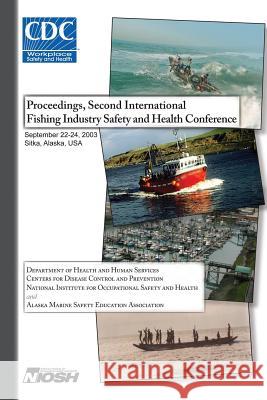Proceedings of the Second International Fishing Industry Safety and Health Conference » książka
Proceedings of the Second International Fishing Industry Safety and Health Conference
ISBN-13: 9781496027801 / Angielski / Miękka / 2014 / 404 str.
Proceedings of the Second International Fishing Industry Safety and Health Conference
ISBN-13: 9781496027801 / Angielski / Miękka / 2014 / 404 str.
(netto: 98,79 VAT: 5%)
Najniższa cena z 30 dni: 103,45
ok. 16-18 dni roboczych
Dostawa w 2026 r.
Darmowa dostawa!
Commercial fishermen continue to risk their lives and livelihood as they labor to bring food to tables around the world. Few occupations are as dangerous as that of a commercial fisherman's, and we at the National Institute for Occupational Safety and Health place the safety of these workers as a high priority. We call upon the readers of this proceedings volume to join our efforts to support safety training for commercial fishermen and the acquisition and use of safety equipment, including personal flotation devices, survival suits, and radio equipment, for all commercial fishing vessels. While we may not be able to control the harsh environment in which commercial fishing takes place, we certainly can promote safer vessels and survival training for workers in the commercial fishing industry. Fatal traumatic injuries in commercial fishing have resulted in this industry being one of the most hazardous in Alaska, the United States, and many other nations. The International Labour Organization (ILO) and Food and Agriculture Organization (FAO) estimate that 7% of all worker fatalities worldwide occur in the fishing industry, even though this industry accounts for less than 1% of the worldwide workforce. The fatality rate for U.S. commercial fishermen was 168 per 100,000 workers per year from 1994 through 1998, 35 times the overall US occupational fatality rate (4.8 per 100,000 workers per year) (CFOI). Around the world, for example, in Australia, Denmark, Finland, Korea, and Sweden, occupational fishing fatality rates range from 16 to as much as 79 times higher than these countries' overall occupational fatality rate. The ILO has estimated that the fishing industry experiences 24,000 deaths and as many as 24 million nonfatal injuries each year worldwide. To bring together fishermen, fishing safety proponents and professionals, government officials, equipment manufacturers, and other parties interested in fishing safety and health, the Alaska Field Station, National Institute for Occupational Safety and Health, organized the Fishing Industry Safety and Health (FISH) conferences. The first two (Anchorage, Alaska, in 1992, and Seattle, Washington, in 1997) were national in scope. As these were well-attended and included participants wanting to learn from other countries where fishing was of economic significance, we decided to broaden the scope of the next conference. Thus, the first International Fishing Industry Safety and Health Conference (IFISH) was held in Massachusetts, in October of 2000, in collaboration with the Harvard School of Public Health. That meeting was well attended and included representatives from many nations. In late September of 2003, working with the Alaska Marine Safety Education Association, we held IFISHII in Sitka, Alaska, which drew 135 registrants from 18 nations. Forty speakers addressed topics ranging from deck safety needs for crabbers working in northern waters to policy changes affecting Pacific Island States. IFISH II's focus on safer working environments for commercial fishermen is part of a growing international emphasis on the need for collaboration among governments, nongovernmental entities, vessel owners and operators, and fishermen themselves to develop effective safety programs. Although fishermen from Sri Lanka sometimes face different types of problems than do fishermen from Sweden or the United States, all of them are operating offshore, usually at some distance from emergency help. The range of subjects in this proceeding volume is impressive, from risk factor analyses to intervention approaches, some rooted in practicalities and success, some more theoretical. Gathering people from fishing countries spread around the globe at an event like IFISH II helps us all to identify programs, equipment, and policies that are effective in promoting fishing safety.
Zawartość książki może nie spełniać oczekiwań – reklamacje nie obejmują treści, która mogła nie być redakcyjnie ani merytorycznie opracowana.











